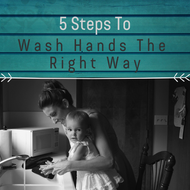5 Steps To Wash Hands The Right Way
Posted by Kelsey Johnson on 21st Mar 2020
Washing hands is something we are taught from infancy. It is so simple yet SO important. It is a good idea to be aware of what truly is involved in order to wash our hands properly. Sometimes it is the simple things that we tend to get lax about, but with all of the dangerous viruses and sicknesses we really should stay vigilant to possible dangers.
Those of us with young ones should be even more cautious and educated on proper washing techniques. Here is a list regarding when we should always remember to wash our hands.

- Before, during, and after preparing food
- Before eating food
- Before and after caring for someone at home who is sick
- Before and after treating a cut or a wound
- After using the toilet
- After changing diapers or cleaning up a child who has used the toilet
- After blowing your nose, coughing, or sneezing
- After touching an animal, animal food, or animal waste
- After handling pet food or pet treats
- After touching garbage
Yes, that is a lot of washing! But I cannot emphasize enough how important hand washing is! Now let's discuss the proper way to wash our hands. It can be so easy to turn on the water, wet our hands, squirt some soap and wipe it around for a second or two then quickly rinse and call it good. Research has shown that may not be enough. Yes, we all live very busy lives and it can be easy to rush through things that may seem mundane. Let me assure you, washing your hands is something none of us should rush through. By doing so properly we can protect ourselves and our loved ones from harmful germs.

So lets all follow these five steps:
- Wet your hands with clean, running water (warm or cold). Then turn off the tap, and apply soap. Why? Because hands can be recontaminated if placed in standing water that has been contaminated through previous use. Clean running water should be used. Surprisingly the temperature of the water does not appear to affect microbe removal; However, warmer water may cause more skin irritation and is environmentally more costly. Turning off the faucet after wetting hands saves water, and there are few data to prove whether significant amount of germs are transferred between hands and the faucet.
- Lather your hands by rubbing them together with soap. Lather the backs of your hands, between your fingers, and under your nails. Why? Using soap to wash hands is more effective than using water alone because the surfactants in soap lift soil and microbes from skin. Plus people tend to scrub hands more thoroughly when using soap, which further removes germs. Lathering and scrubbing your hands causes friction, which helps lift the dirt, grease, and microbes from skin. For anyone who didn't know what surfactants are, I didn't know what they were either! Haha! I looked it up and it is the element in soap which when liquid is applied causes the soap to spread.
- Scrub your hands for at least 20 seconds. Sing the ABC song including the end part, “Now I know my ABC’s next time won't you sing with me.” The optimal length of time for hand washing is also likely to depend on many factors, including the type and amount of "muck" on the hand and the setting of the person washing hands. For example a surgeon obviously needs to wash hands much longer than someone who is just preparing their lunch.
- Rinse your hands well under clean, running water. Rinsing the soap away also minimizes skin irritation.
- Dry your hands using a clean towel or air dry them. Why? Germs can be transferred more easily to and from wet hands; Therefore hands should be dried after washing.
Washing hands with soap and water is the best way to get rid of germs in most situations. In the event that you cannot use soap and water you can use hand sanitizer. You can use an alcohol based hand sanitizer that contains at least 60% alcohol. If you would like a natural hand sanitizer, try DAYSPA Body Basics Hand Sanitizers. They come in multiple fresh scents from essential oils, and contain 62% Ethyl Alcohol.
Some things to keep in mind regarding hand sanitizer is:
-It does not get rid of all types of germs.
-It may not be as effective when hands are visibly dirty or greasy
-And it might not remove harmful chemicals from hands like pesticides and heavy metals.
Keep in mind, washing hands constantly is great to get rid of germs, but it can cause skin irritation is some cases. That is why a natural gentle soap is helpful. Also following up with lotion or Calendula Butter Hand Balm in more extreme cases. I speak from experience, sadly I get a horrible skin rash when I have to wash my hands a ton. That is why I love DAYSPA Body Basics products! The liquid soap is gentle on my irritated skin yet works great to remove filth and germs. Then I follow up with the lotion or like I mentioned earlier, when my skin gets severely irritated I use the Calendula Butter Hand Balm.
To conclude, lets all take the proper steps to help eliminate the spread of harmful germs; Try and avoid busy places if at all possible, regularly sanitize frequently touched surfaces, wash hands thoroughly, and remember if you or one of your family members are sick stay home until you have not had a fever for 24 hours without medication. Please stay safe and stay healthy!
